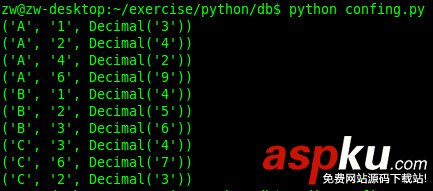一、web框架本质
1.基于socket,自己处理请求
#!/usr/bin/env python3#coding:utf8import socketdef handle_request(client): #接收请求 buf = client.recv(1024) print(buf) #返回信息 client.send(bytes('<h1>welcome liuyao webserver</h1>','utf8'))def main(): #创建sock对象 sock = socket.socket() #监听80端口 sock.bind(('localhost',8000)) #最大连接数 sock.listen(5) print('welcome nginx') #循环 while True: #等待用户的连接,默认accept阻塞当有请求的时候往下执行 connection,address = sock.accept() #把连接交给handle_request函数 handle_request(connection) #关闭连接 connection.close()if __name__ == '__main__': main() 2.基于wsgi
WSGI,全称 Web Server Gateway Interface,或者 Python Web Server Gateway Interface ,是为 Python 语言定义的 Web 服务器和 Web 应用程序或框架之间的一种简单而通用的接口。自从 WSGI 被开发出来以后,许多其它语言中也出现了类似接口。
WSGI 的官方定义是,the Python Web Server Gateway Interface。从名字就可以看出来,这东西是一个Gateway,也就是网关。网关的作用就是在协议之间进行转换。
WSGI 是作为 Web 服务器与 Web 应用程序或应用框架之间的一种低级别的接口,以提升可移植 Web 应用开发的共同点。WSGI 是基于现存的 CGI 标准而设计的。
很多框架都自带了 WSGI server ,比如 Flask,webpy,Django、CherryPy等等。当然性能都不好,自带的 web server 更多的是测试用途,发布时则使用生产环境的 WSGI server或者是联合 nginx 做 uwsgi 。
python标准库提供的独立WSGI服务器称为wsgiref。
#!/usr/bin/env python#coding:utf-8#导入wsgi模块from wsgiref.simple_server import make_serverdef RunServer(environ, start_response): start_response('200 OK', [('Content-Type', 'text/html')]) return [bytes("welcome webserver".encode('utf8'))]if __name__ == '__main__': httpd = make_server('', 8000, RunServer) print ("Serving HTTP on port 8000...") httpd.serve_forever() #接收请求 #预处理请求(封装了很多http请求的东西) 请求过来后就执行RunServer这个函数。
原理图:
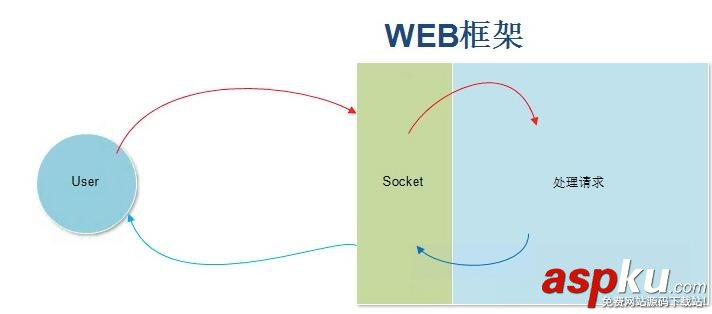
当用户发送请求,socket将请求交给函数处理,之后再返回给用户。
二、自定义web框架
python标准库提供的wsgiref模块开发一个自己的Web框架
之前的使用wsgiref只能访问一个url
下面这个可以根据你访问的不同url请求进行处理并且返回给用户
#!/usr/bin/env python#coding:utf-8from wsgiref.simple_server import make_serverdef RunServer(environ, start_response): start_response('200 OK', [('Content-Type','text/html')]) #根据url的不同,返回不同的字符串 #1 获取URL[URL从哪里获取?当请求过来之后执行RunServer, #wsgi给咱们封装了这些请求,这些请求都封装到了,environ & start_response] request_url = environ['PATH_INFO'] print (request_url) #2 根据URL做不同的相应 #print environ #这里可以通过断点来查看它都封装了什么数据 if request_url == '/login': return [bytes("welcome login",'utf8')] elif request_url == '/reg': return [bytes("welcome reg",'utf8')] else: return [bytes('<h1>404! no found</h1>','utf8')]if __name__ == '__main__': httpd = make_server('', 8000, RunServer) print ("Serving HTTP on port 8000...") httpd.serve_forever() 当然 以上虽然根据不同url来进行处理,但是如果大量url的话,那么代码写起来就很繁琐。
所以使用下面方法进行处理
#!/usr/bin/env python#coding:utf-8from wsgiref.simple_server import make_serverdef index(): return [bytes('<h1>index</h1>','utf8')]def login(): return [bytes('<h1>login</h1>','utf8')]def reg(): return [bytes('<h1>reg</h1>','utf8')]def layout(): return [bytes('<h1>layout</h1>','utf8')]#定义一个列表 把url和上面的函数做一个对应urllist = [ ('/index',index), ('/login',login), ('/reg',reg), ('/layout',layout),]def RunServer(environ, start_response): start_response('200 OK', [('Content-Type','text/html')]) #根据url的不同,返回不同的字符串 #1 获取URL[URL从哪里获取?当请求过来之后执行RunServer,wsgi给咱们封装了这些请求,这些请求都封装到了,environ & start_response] request_url = environ['PATH_INFO'] print (request_url) #2 根据URL做不同的相应 #print environ #这里可以通过断点来查看它都封装了什么数据 #循环这个列表 找到你打开的url 返回url对应的函数 for url in urllist: if request_url == url[0]: return url[1]() else: #url_list列表里都没有返回404 return [bytes('<h1>404 not found</h1>','utf8')] if __name__ == '__main__': httpd = make_server('', 8000, RunServer) print ("Serving HTTP on port 8000...") httpd.serve_forever() 三、模板引擎
对应上面的操作 都是根据用户访问的url返回给用户一个字符串的 比如return xxx
案例:
首先写一个index.html页面
内容:
<!DOCTYPE html><html lang="en"><head><meta charset="UTF-8"><title>index</title></head><body><h1>welcome index</h1></body></html>
login.html页面
内容:
<!DOCTYPE html><html lang="en"><head> <meta charset="UTF-8"> <title>login</title></head><body> <h1>welcome login</h1> <form> user:<input type="text"/> pass:<input type="password"/> <button type="button">login in</button> </form></body></html>
python代码:
#!/usr/bin/env python #coding:utf-8from wsgiref.simple_server import make_serverdef index(): #把index页面读进来返回给用户 indexfile = open('index.html','r+').read() return [bytes(indexfile,'utf8')]def login(): loginfile = open('login.html','r+').read() return [bytes(loginfile,'utf8')]urllist = [ ('/login',login), ('/index',index),]def RunServer(environ, start_response): start_response('200 OK', [('Content-Type','text/html')]) #根据url的不同,返回不同的字符串 #1 获取URL[URL从哪里获取?当请求过来之后执行RunServer,wsgi给咱们封装了这些请求,这些请求都封装到了,environ & start_response] request_url = environ['PATH_INFO'] print (request_url) #2 根据URL做不同的相应 #print environ #这里可以通过断点来查看它都封装了什么数据 for url in urllist: #如果用户请求的url和咱们定义的rul匹配 if request_url == url[0]: #执行 return url[1]() else: #url_list列表里都没有返回404 return [bytes('<h1>404 not found</h1>','utf8')]if __name__ == '__main__': httpd = make_server('', 8000, RunServer) print ("Serving HTTP on port 8000...") httpd.serve_forever() 但是以上内容只能返回给静态内容,不能返回动态内容
那么如何返回动态内容呢
自定义一套特殊的语法,进行替换
使用开源工具jinja2,遵循其指定语法
index.html 遵循jinja语法进行替换、循环、判断
先展示大概效果,具体jinja2会在下章django笔记来进行详细说明
index.html页面
内容:
<!DOCTYPE html><html lang="en"><head> <meta charset="UTF-8"> <title>Title</title></head><body> <!--general replace--> <h1>{{ name }}</h1> <h1>{{ age }}</h1> <h1>{{ time }}</h1> <!--for circular replace--> <ul> {% for item in user_list %} <li>{{ item }}</li> {% endfor %} </ul> <!--if else judge--> {% if num == 1 %} <h1>num == 1</h1> {% else %} <h1>num == 2</h1> {% endif %}</body></html> python代码:
#!/usr/bin/env python#-*- coding:utf-8 -*-import time #导入wsgi模块from wsgiref.simple_server import make_server#导入jinja模块from jinja2 import Templatedef index(): #打开index.html data = open('index.html').read() #使用jinja2渲染 template = Template(data) result = template.render( name = 'yaoyao', age = '18', time = str(time.time()), user_list = ['linux','python','bootstarp'], num = 1 ) #同样是替换为什么用jinja,因为他不仅仅是文本的他还支持if判断 & for循环 操作 #这里需要注意因为默认是的unicode的编码所以设置为utf-8 return [bytes(result,'utf8')]urllist = [ ('/index',index),]def RunServer(environ, start_response): start_response('200 OK', [('Content-Type', 'text/html')]) #根据url的不同,返回不同的字符串 #1 获取URL[URL从哪里获取?当请求过来之后执行RunServer, # wsgi给咱们封装了这些请求,这些请求都封装到了,environ & start_response] request_url = environ['PATH_INFO'] print(request_url) #2 根据URL做不同的相应 #循环这个列表 for url in urllist: #如果用户请求的url和咱们定义的rul匹配 if request_url == url[0]: print (url) return url[1]() else: #urllist列表里都没有返回404 return [bytes('<h1>404 not found</h1>','utf8')]if __name__ == '__main__': httpd = make_server('', 8000, RunServer) print ("Serving HTTP on port 8000...") httpd.serve_forever() 四、MVC和MTV
1.MVC
全名是Model View Controller,是模型(model)-视图(view)-控制器(controller)的缩写,一种软件设计典范,用一种业务逻辑、数据、界面显示分离的方法组织代码,将业务逻辑聚集到一个部件里面,在改进和个性化定制界面及用户交互的同时,不需要重新编写业务逻辑。MVC被独特的发展起来用于映射传统的输入、处理和输出功能在一个逻辑的图形化用户界面的结构中。
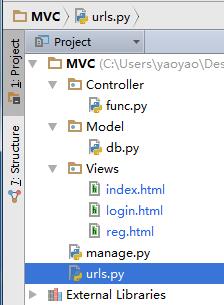
将路由规则放入urls.py
操作urls的放入controller里的func函数
将数据库操作党风model里的db.py里
将html页面等放入views里
原理图:
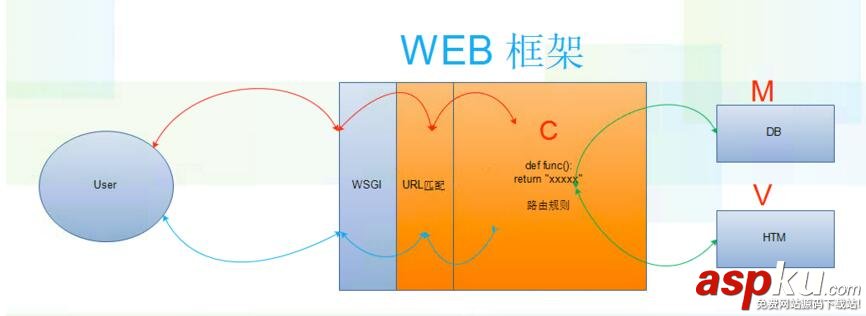
2.MTV
Models 处理DB操作
Templates html模板
Views 处理函数请求
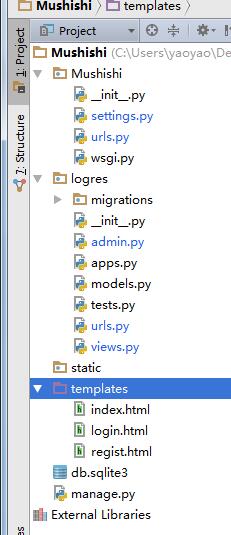
原理图:
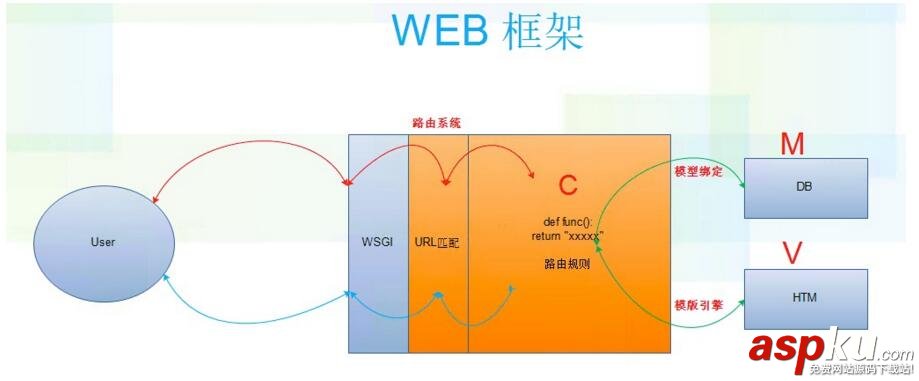
以上就是本文的全部内容,希望对大家的学习有所帮助。






















